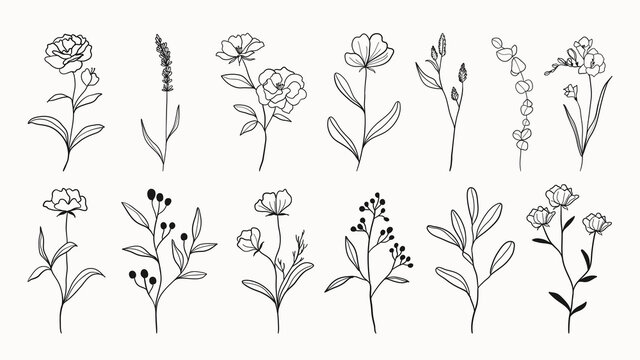Flower Drawing: A Blossoming Hobby for Everyone
Have you ever looked at a beautiful flower and thought, “I wish I could capture that on paper”? If so, you’re not alone. Flower drawing is a beloved pastime that combines the beauty of nature with the joy of creativity. Whether you’re a seasoned artist or a complete beginner, drawing flowers can be a rewarding and relaxing activity. Let’s explore how you can start this delightful hobby and improve your skills along the way.
Why Draw Flowers?
Flowers are not just beautiful to look at; they are also fantastic subjects for artists. They come in a variety of shapes, sizes, and colors, making them perfect for experimentation. Drawing flowers can help you improve your observation skills, fine-tune your attention to detail, and develop your artistic style. Plus, it’s a wonderful way to bring a piece of nature indoors.
Getting Started: The Basics
Starting with flower drawing doesn’t require expensive materials or extensive training. All you need is some paper, a pencil, and an eraser. If you want to add color, colored pencils, markers, or watercolors are great options. Here’s a simple guide to get you started.
Choosing Your Subject
Begin by selecting a flower that appeals to you. It could be a rose from your garden, a daisy from a nearby park, or even a photo from the internet. Look for a flower with a clear structure and distinct features, as this will make it easier to draw.
Observing Your Flower
Take a moment to study your chosen flower. Notice its shape, the way the petals overlap, and how the stem and leaves are positioned. Observation is key to capturing the essence of your subject. Spend some time looking at the flower from different angles to understand its form better.
Sketching the Outline
Start with a light sketch of the flower’s basic shape. Don’t worry about details at this stage; focus on capturing the general outline. Use simple shapes like circles and ovals to represent the flower and its parts. This will serve as the foundation for your drawing.
Adding Details
Once you have the outline, begin adding details. Observe the petals and draw their shapes more accurately. Pay attention to the curves and edges. Add the stem and leaves, ensuring they are proportionate to the flower. Keep your lines light so you can easily make adjustments.
Techniques for Drawing Different Flowers
Different flowers require different approaches. Here are some tips for drawing a few popular types of flowers.
Drawing a Rose
Roses are known for their intricate petals and elegant shape. Start with a small circle for the center. From there, draw the petals, working from the inside out. Roses have overlapping petals, so take your time to draw each petal carefully. Add shading to give the rose depth and dimension.
Drawing a Daisy
Daisies are simpler in structure. Begin with a small circle for the center. Then draw long, slender petals radiating outward. Keep the petals uniform in size and shape. Add texture to the center with small dots or lines.
Drawing a Sunflower
Sunflowers are bold and striking. Start with a large circle for the center. Draw the petals around the center, making them long and pointed. Sunflower petals are often layered, so add a second layer behind the first. Don’t forget the distinctive texture of the sunflower’s center, which you can achieve with a series of small, overlapping lines.
Adding Color to Your Drawings
Adding color can bring your flower drawings to life. Here’s how to do it effectively.
Using Colored Pencils
Colored pencils are great for detailed work. Start with a base layer of light color and gradually add darker shades to create depth. Use gentle, circular motions to blend the colors smoothly.
Watercolor Techniques
Watercolors offer a soft, dreamy quality to your drawings. Begin with a light wash of color and build up layers gradually. Use a fine brush for details and a larger brush for broader areas. Experiment with wet-on-wet and wet-on-dry techniques to achieve different effects.
Markers and Pens
Markers and pens provide bold, vibrant colors. Use them for outlining and adding sharp details. Be mindful of the type of paper you use, as some markers can bleed through.
Practicing and Improving Your Skills
Like any other skill, drawing flowers improves with practice. Here are Flower Drawing some tips to help you along the way.
Daily Practice
Dedicate a few minutes each day to drawing flowers. Start with quick sketches and gradually move on to more detailed drawings. Consistent practice will help you develop muscle memory and improve your technique.
Studying Other Artists
Look at how other artists draw flowers. Study their techniques and try to understand their approach. You can find inspiration in art books, online tutorials, and galleries.
Seeking Feedback
Don’t hesitate to share your work with others. Join online art communities or take part in local art classes. Constructive feedback can provide valuable insights and help you grow as an artist.
Enjoying the Process
Remember, the goal of drawing flowers is to enjoy the process. Don’t get discouraged if your drawings don’t turn out perfect at first. Art is about expression and creativity, not perfection. Allow yourself to experiment, make mistakes, and learn from them.
Conclusion: The Beauty of Flower Drawing
Flower drawing is a wonderful way to connect with nature and express your creativity. With a little practice and patience, anyone can learn to draw beautiful flowers. So grab your sketchbook, find a flower that inspires you, and start drawing. Who knows? You might discover a new passion and a newfound appreciation for the intricate beauty of flowers.




Post Comment